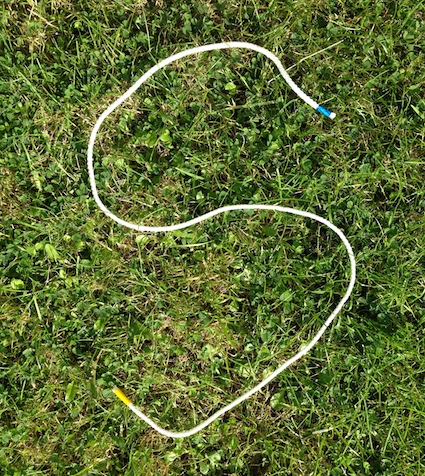
This past year I have had my passion for ropes revived. It all began quite innocently during as I was co-presenting a Forest Kindergarten course with Marian Cairns. She was talking about Sammy the Snake – a piece of thin rope she used with children to help them learn to tie knots. One end of the rope had red tape and the other blue, so that children could distinguish between the two ends.
I couldn’t help viewing Sammy the Snake as a floppy stick. Sticks are hard and have lots of mathematical uses. However, as shapes need both straight and curved edges, I realised that my straight sticks finally had a curvy rope companion.
Here’s some mathematical ways I’ve used the little pieces of rope:
I talk about Sammy the Snake as a helpful friend
It means little stories can be developed around his mathematical life. Children relate well to this and it adds an extra dimension to the learning. There is some research evidence to suggest that children can better understand concepts such as conservation of number when stories and characters are used.
My little snakes are one-metre long
This enables them to be used as a standard unit for measuring purposes. Objects which have curves such as lamp posts, tree trunks and car wheels are much easier to measure. The challenge is to find something that is exactly one metre long. Then Sammy the Snake is especially pleased, just like when we realise we are the same height as something.
The snake is a useful impartial judge
This is helpful during games such as the stick measuring game. When a bent stick is placed on the sheet and discussions arise as to whether it is longer than a nearby straight stick, then the snake can be used for measuring the length.
Estimating one-metre
A challenge for older children who have had experience of using one-metre to measure objects is to create a metre using materials available outside. It is a great way of finding out who has a conceptual understanding of one-metre. It is also worth having a discussion about how the children did this task. What did they use as reference points? For example, some people go for the length of a stride. Others will use objects such as the side of a clipboard and use this as a guide to creating a metre. Children can check their results using the metre-long rope.
The snake is an introduction to fractions and the concept of halves and quarters
Sammy the snake does exercises to keep fit and flexible. He is really proud of his ability to bend over and make his head touch his tail. He discovered that not only can he fold himself in half, on a good day he can even make himself into quarters. A beautiful explanation of using string for introducing the concept of equivalence is found in Nick Tiley-Nunn’s book, Primary Maths – Anyone Can Feed Sweets to Sharks.
The snakes make quick shapes and sets
Sticks are great for making quick shapes such as squares and rectangles. But rope snakes make circles, ovals and other curved shapes. This is useful for making both discrete and overlapping sets such as Venn Diagrams. So wherever you are working, it is possible to sort and classify objects.
Investigate shapes with a snake
It’s also possible to do lots of other shape investigations. Add in camping pegs, tie Sammy in a knot and see what shapes can be made. The pegs can be used at the corners of shapes. How many pegs are needed to make Sammy the Snake become a square? What about a triangle? What do you notice about the number of pegs you use and the variety of shapes Sammy the Snake can make with his body?
Conservation of length
Children often believe that a piece of rope coiled up is shorter than when it is rolled out. Sammy the Snake can be helpful here. He likes to take a nap where he rolls himself up small. He does this for many reasons: he keeps himself warm and snug. He takes up less space so can sleep in a hole or a pocket. Children can compare his length to another 1-metre piece of rope and see for themselves that Sammy doesn’t change his length when he curls up, he simply has found a way of fitting into a small space.
Creating snaky digits
Another little story which works well is how Sammy likes to learn to recognise his numbers by making twisting and turning his body into each number. Can the children make his body do this? Can they make the shapes with their own body?
Type of rope used
I used cheap white rope. For several reasons:
- It’s visible. It can be easily seen on a range of different surfaces.
- It’s static and doesn’t stretch. This is better for accurate measurements.
- It’s cheap. So I can make up lots for little money.
- It’s flexible enough to roll up and keep inside my jacket pocket. Every educator needs a metre in their pocket.
I’d love to know how you get on with using Sammy the 1-metre Snake. Please write your experiences below. I’ve also used Sammy for literacy work too but that’s for another blog post.
For those who live in countries who have snakes, then Sammy can also be used to help children learn to check for snakes in their backyards or outdoor spaces. Sammy and his friends can be hidden in places such as tyres so that children learn to check first before using.






























My P1 had a great time with Sammy the snake this week. Hide and seek was a favourite, as was tying the rope around objects to carry them eg ice, sticks etc
Thanks for the feedback. It sounds like Sammy had great fun too! I love the suggested uses. Much appreciated. I hope others share their ideas too.